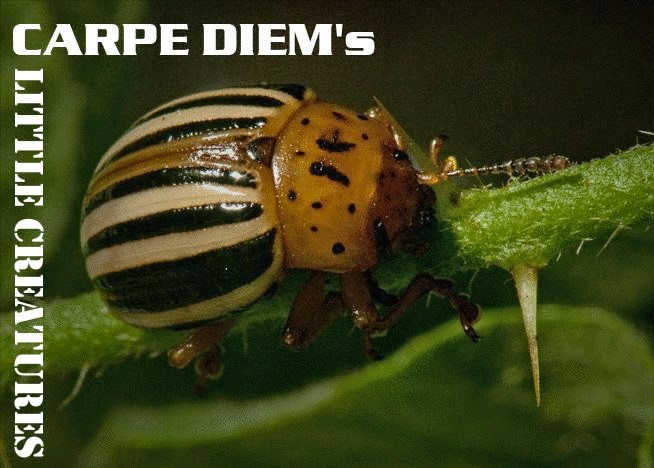Dear Haijin, visitors and travelers,
It's Saturday again and this week we have a new episode of our bi-weekly "Little Creatures" feature in which the goal is to write a classical haiku (following the rules as mentioned in Lecture 1) and share it with us all.
In this special feature I share haiku about "little creatures" (insects, birds, flowers etc.) composed by classical or non-classical haiku-poets, known and unknown. And this week I have chosen for a haiku composed by my haiku-master Basho.
yamaji kite naniyara yukashi sumire-gusa
coming along the mountain path,
there is something touching
about these violets
© Basho (Tr. R.H.Blyth)
Naniyara expresses Basho's unwillingness to notice the violet, to make a verse on it. Somehow or other it compels him to notice it, importuning him like a weeping infant;
"a violet by a mossy stone half hidden from the eye"
This flower and the heart of Basho's have some deep affinity. It's even said that Basho wrote this while on one of his journeys encountering a beautiful man. As you maybe know Basho was interested in the homosexual love. The truth will be staying in the middle ....
Buson also wrote about violets, but his observation was more objective and not subjective as is the one by Basho.
suwaritaru fune wo agareba sumire kana
getting off the boat
that had grounded, -
the violets!
© Buson (Tr. R.H. Blyth)
 |
| Violets |
sumire tsumeba chiisaki haru no kokoro kana
picking a violet, -
the slender
heart of spring!
© Gyodai
And here is another beauty written by Naojo:
tsumu mo ashi tsumanu mo ashiki sumire kana
to pluck it is a pity,
to leave it is a pity,
Ah, this violet!
© Naojo
For closure, when the violet is held in the hand, it seems alsmost an extension of one's own body, giving a feeling of intimacy beyond the power of the eye. Koshu describes this in his haiku:
te ni toreba nao utsukushiki sumire kana
the violet:
held in the hand,
yet more lovely
© Koshu
This last verse (by Koshu) could have been written by Basho as one would follow the explanation that Basho was interested in the love between man ...
 |
| Violets |
fragile and
a beauty,
the purple leaves like velvet,
cherished in the rain
© Chèvrefeuille
The above version is in my opinion very artificial, but I ask you to write a classic haiku so I have to do that myself too. However my first version of this above haiku is more beautiful (as I may say so). It's not in the classical way, more like the "free style" of Santoka Taneda (1882-1940) so if you don't mind I love to share that (first) version also here:
the purple leaves like velvet,
cherished in the rain
© Chèvrefeuille
The above version is in my opinion very artificial, but I ask you to write a classic haiku so I have to do that myself too. However my first version of this above haiku is more beautiful (as I may say so). It's not in the classical way, more like the "free style" of Santoka Taneda (1882-1940) so if you don't mind I love to share that (first) version also here:
fragile beauty,
these purple leaves like velvet,
cherished in the rain
© Chèvrefeuille
these purple leaves like velvet,
cherished in the rain
© Chèvrefeuille
By the way ... I think you have noticed it. In these two haiku by myself I have used punctuation and that's new for my haiku ... I never use punctuation, because without punctuation the reader, you, can decide the tone by yourself. With punctuation I take your freedom of mind away ... and that's certainly not my way of being a haiku poet.
This episode is open for your submissions today at noon (CET) and it will remain open until next Saturday March 14th at noon (CET). Have fun!

Really atmospheric haiku, Chevrefeuille, and so interesting, about the punctuation
ReplyDeleteHi, Kristjaan.
ReplyDeleteI'm so happy to share a link here, again. I am aware it's not a classical haiku, because it has the "personal" touch in it. Yet, recently, I haven't been able to write anything without a personal touch. It's been that sort of time...
Friendly hugs,
MK
Love your violet poems! I agree the first one is less artificial.
ReplyDelete